Custom Foot & Ankle Braces
Our Ankle Brace Range
At The Northern Ireland Foot & Ankle Clinic we use various methods of casting the foot and ankle. From simple foam impression casts to full foot and ankle plaster casts. What happens next is what really makes the difference. Your cast is filled and stripped out to form a plaster positive. The positive cast is then cleaned and balanced, before being used to vacuum your custom orthotic shell. We guarantee that no computer profiles or preformed shapes are used in our manufacture process. Finally, the shell is balance posted and covered with a suitable covering material. View our FAQs to see if your question has been answered.
Custom Modified AR Brace
This is a custom Arizona style brace. It has a soft gauntlet exterior with a fully custom AFO lining. Where needed medial or lateral stirrup straps can be added to increase support.
Clinical indications
- Rigid, non-reducible Adult Acquired Flatfoot.
- Severe DJD or Deformity of the hindfoot
- Charcot Arthropathy
- Partial or complete drop foot
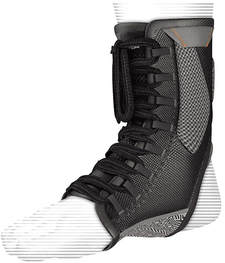

Elife Functional Hinged Ankle Brace
This brace is made from a combination of flexible plastics with ankle articulation and cushioned strapping. The multiple straps enable the user adjustably to apply corrective forces to both the foot and ankle. The base plate can be easily replaced with a full custom plater which can be extended along the length of the foot. The device has minimal bulk which allows it to be used in almost any shoes.
Clinical indications
- Tibialis posterior dysfunction
- Partial or complete drop foot( with Bungie attachment)
Gauntlet Style Ankle Brace with Side Stabilizers and Cross Auxiliary Fixing Belts
This ankle support is a lightweight protective foot and ankle orthosis, suitable for recurrent ankle sprains, ankle ligament injury. It provides protection during movement. It is suitable for patients with both valgus and varus sprains.
Clinical indications
- Used to support the medial longitudinal arch and can have a custom arch insert fitted
- Lateral ankle instability
- Mild foot drop
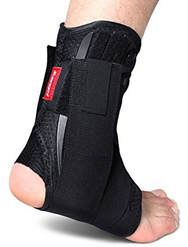
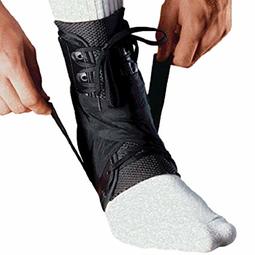
Laced Gauntlet Ankle Stabilizer Brace with Support Stirrup
The brace is designed with 2 straps that form a figure 8 to protect and support ankle and foot, This brace fits comfortably into normal shoes and its non-stretch stabilizing straps mirror the stirrup technique of an athletic taping procedure. By replicating ankle taping, it allows the patient to secure the foot into the required position.
Clinical indications
- Used predominantly for sport activities
- Lateral ankle instability
- Medial ankle instability
- Mild tibialis posterior strain
Gauntlet Ankle Brace with Figure-8 Strap
A strong rearfoot support brace normally used in conjunction with a full custom insert. The insert can be foot only or can be a full AFO lining.
Clinical indications
- Mild to moderate tibialis posterior dysfunction, as the custom liner can be easily modified both in shape and flexibility this brace is particularly suited to the younger more active patient who may be involved in sporting activities
- Patients with ankle instability
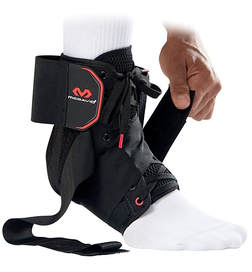
Slings and stirrup straps
While shown here attached to an articulating brace, slings and stirrup straps can be attached to any of the braces listed above where they are not already present
Adjustable Medial Sling
The medial sling is designed to give the patient control over the level of support achieved with their brace. It consists of a soft padded arch filler attached to an adjustable Velcro strap.
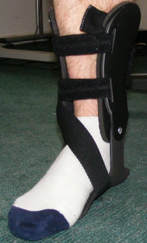
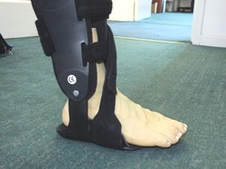
Adjustable Lateral Sling
The lateral sling is designed to give adjustable support under the lateral border of the foot for patients who have suffered with lateral instability. The velcro strap is easily tightened to increase support when needed or to reduce support as the ankle recovers.
Double Sling Cradle
As the name suggests this brace has two crossing straps which allow the patient to adjust the level of pull in either direction. The double-cradle effect then completely stabilizes the foot in the required position.
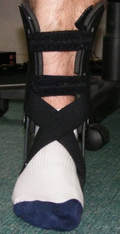
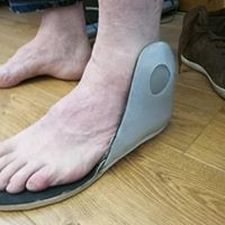
Custom Semi Brace Devices
The semi brace is designed for patients who either already have a full ankle brace or for those who are close to needing a full brace but prefer a device which is easier to use and less visible and obtrusive. The device seen here flanges right up over the ankle joint either on the inside of the ankle for those with severely collapsed feet and ankles or on the outer ankle for those with chronic lateral ankle instability. As with all our custom devices these are made to the exact specification required by the patient. The semi brace is best suited to being worn inside a boot which supports the function of the device
Drop Foot Braces
Custom Fixed Ankle Brace
This is a traditional AFO style brace with medial arch support. It can be supplied as seen here or with a rocker bottom. All though these braces have to some extent been superseded by more advanced devices, they can still be of great benefit for some patients.
Clinical indications
- Severe Drop foot conditions were spasticity is prohibiting the use of articulating braces.
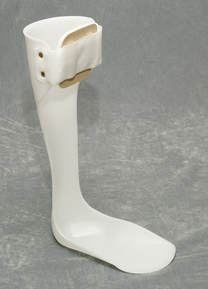
Dorsiflexory Bungie Brace
The latest addition to our range is the new dorsiflexion assist drop foot brace. For patients with a drop foot condition, this is one of the easiest to use and least obtrusive braces available anywhere. This device which uses a simple bungee cord to mimic the function of the muscles which dorsiflex the foot is fully adjustable. The upward movement at the ankle can be engaged and disengaged by means of a simple hook. The beauty of these braces is that they allow you to walk much more normally than a fixed position brace.
This has three primary effects:
1) By not limping the muscles around the pelvis and hips function much more normally and the patient does not fatigue as quickly when walking.
2) by walking more normally the patient is much less likely to develop early arthritic changes in the knees and hips.
3) The ankle itself benefits from using more of its original range of motion. The foot can also be pulled into eversion or inversion by means of a 2 bungee sling.
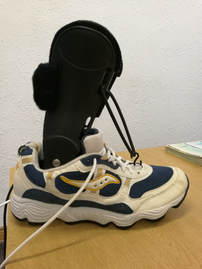
The Ease Forward Ankle Rocker System
The first Ease Forward Ankle Rocker was issued in 2011 to a patient who had a severe ankle injury due to a bomb blast and who went on to successfully complete the Belfast Marathon.
As a general rule splints and braces act by reducing joint movements, however the rocker acts by replacing lost movement by mimicking the function of the ankle joint. It thus reduces greatly the stress in the lower limb caused by a limitation of normal ankle function.
Since 2011 the rocker has been extensively used for patients with limited ankle movement. This limitation may be due to trauma, arthritis, or congenital deformities. It has been successful in preventing patients from having surgical procedures as well as helping patients who have had ankle or foot surgery.
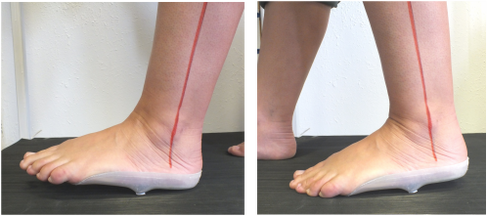
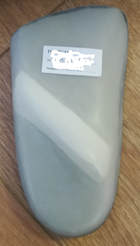
Transverse Offset Rockers
We were recently asked to produce a device that would rock a patients ankle into a more stable position. The patient had suffered a left-sided below-knee amputation and a degloving of her right foot. The extensive soft tissue injury to the right foot left her with a plantarflexed and laterally unstable ankle. She was treated with a Transverse offset rocker brace to dynamically stabilizer her foot and ankle while still allowing a relatively normal walking pattern.
The rocker which normally rocks the foot in the sagittal plane only was rotated to produce both sagittal and frontal plane movement. This had the effect of rocking the patient into an improved more stable position. The rocker was used in conjunction with transverse offset mid-sole heel raise.
Rocker Braces
The rocker brace represents the pinnacle of ankle brace design. Now used extensively for patients with injured or arthritic ankle joints or in any situation where there is a reduction in normal ankle function including surgical fixation. It was originally designed in 2011 for a patient who had stepped on explosive device, the rocker brace has been used for patients with severe ankle injuries from Ireland to Australia.
Unlike other braces which are primarily designed to reduce movement the rocker is designed to recreate or mimic the normal movement of the ankle joint while giving all the stability to the ankle joint required from a normal brace. The brace comes in two forms
1) Fixed ankle – As the name suggests this device does not articulate at the ankle but rather is set or fixed at a predetermined angle.
2) Full articulation – This device allows the patient to utilize any residual dorsiflexion/plantarflexion motion left in the ankle while providing increased functional movement through the rocker.
The MMSA Brace
Our latest brace was designed for a patient with a ruptured Tibialis posterior. The patient’s personal circumstances didn’t permit her to have surgical intervention so she was referred to us for support. The maximal medial surface area brace (MMSA) not only supports the corrected position of the foot but also reduces stress through the lower limb by providing an alternative movement pathway AMP. This is achieved by the use of the rocker in combination with the support. By providing an alternative pathway it greatly reduces the pronatory (flattening) impulse acting through the foot.

